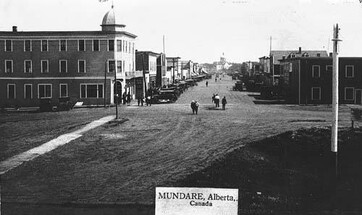
Mundare - Where the Past has a Presence
Mundare is a fairly typical prairie community in that its’ founding was stimulated by the coming of the railway. A settlement of English farmers had been started in the early 1890s on the northeast shore of Beaverhill Lake (some eight miles from the future village), where one of the Scottish homesteaders, J. D. McAllister, opened a blacksmith shop, post office and general store on the pioneer trail from Edmonton. However, as the nineteenth century drew to close the “Beaver Lake” district, as it was then commonly known, rapidly filled with an influx of farmers from Eastern Europe, most of them from Ukrainian lands within the Austro-Hungarian Empire. When a siding was created in 1905 at the future site of Mundare on the new Canadian Northern Railway line between Edmonton and Winnipeg, it soon became a focal point for a village that is thought to have acquired its name from an early stationmaster, W. Mundare. The first merchant to seize on the opportunity was J. D. McAllister, who constructed a general store at the site, followed by a livery barn, lumberyard, and implement shop – while continuing to farm with the help of hired hands! Another pioneer merchant was J. S. McCallum, who by 1906 was operating a store, subsequently expanding into cattle buying, real estate, insurance, and a farm implements dealership.
The village developed on the “T-town” plan widely used on the prairies, with Main Street extending at a right angle to the railway tracks, northwards from the station. Soon, a hotel, hardware store, and other small shops sprang up along Mundare’s main thoroughfare, some of them branches of national chains and others being ventures launched by enterpeneurial-minded Ukrainian settlers. By 1910, Mundare boasted fifteen businesses, a figure that more than doubled in the next decade. Out of necessity, the Scottish Canadian merchants like J.D. McAllister and Joseph McCallum learned to communicate with their Slavic customers in their own language, the latter in particular becoming quite proficient in Ukrainian. McCallum’s linguistic abilities stood him in good stead when he entered provincial politics in 1913, winning election as the Liberal representative for Vegreville constituency until 1921. Among Joe McCallum’s more unusual achievements was his financing of a Ukrainian-language newspaper called Postup (Progress), which he published out of Mundare for several months in 1915 with the help of Illia Kiriak – the future author of the epic novel Syny zemli (Sons of the Soil).
In the meantime, Mundare also became a well-spring of Ukrainian life in rural east central Alberta, spurred by the Beaver Lake district’s selection in 1902 as the missionary centre for the Order of St. Basil the Great and the Sisters Servants of Mary Immaculate. Although initially established on a monastery farm three miles southeast of present-day Mundare (part of which now forms the Parkland Conservation Farm), with the steady growth of the village the focus of church life inevitably shifted into town. In 1909, it was decided to build Sts. Peter and Paul Ukrainian Catholic Church in Mundare, the finished sanctuary being blessed the following year during a historic visit to Canada by Metropolitan Andrii Sheptytsky from Lviv. In 1922, a new monastery was built in town for the Basilian Fathers under the direction of the renowned missionary priest and architect, Fr. Phillip Ruh, a native of Belgium. The Sisters Servants followed suit with the completion of their convent on the north side of Mundare in 1926, at the same time relocating their orphanage and school from its original location on the farm. Work on another major landmark then began in 1932, with the construction of the Grotto, which each year draws thousands of pilgrims to the annual Sts. Peter and Paul Feast Day celebrations in July.
Between 1911 and 1931, the population of Mundare grew impressively from 152 to 832, in the process becoming a major service point for residents in the surrounding countryside. To better provide for the medical needs of the local population, in 1928 the Sisters Servants of Mary Immaculate spearheaded the building of the Mundare Hospital, which welcomed its first patient the following year. In 1962 this care centre was renamed Mary Immaculate Hospital of Mundare, the 1930 structure eventually being replaced by a new building after fifty years of operation.
In the meantime, like other rural towns and villages, Mundare has evolved and adapted with the changing times. Today, it is famous as the home of the Stawnichy Meat Processing Company, whose “Mundare Sausage” or kovbasa (popularly known as “kubasa” or “kubie”) is shipped far and wide across and outside of the province of Alberta. The Stawnichy family began making sausage at their Mundare store in 1959, and the operation has since grown exponentially under the leadership of Ed Stawnichy to produce a huge variety of meat and other food products. You can purchase Stawnichy products at their Main Street Store, just a short distance from the 42-foot high sausage in the Mundare’s heritage park. Across Secondary Highway 854 and beside the first chapel and the newest Sts. Peter and Paul church, is the Basilian Fathers Museum, built in 1990 to showcase the rich history of the mission and the settlements it continues to serve.
Although like most prairie communities Mundare experienced a gradual population loss after the Second World War due to the changing agricultural economy, it is poised to grow once again thanks to the Whitetail Crossing development currently taking shape south of the townsite. Strategically situated just an hour east of Edmonton, Mundare is looking forward to the future with confidence and renewed energy, comfortable with its past but eager to embrace fresh opportunities.
Taken from the Kalyna Country web site
